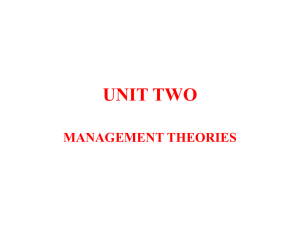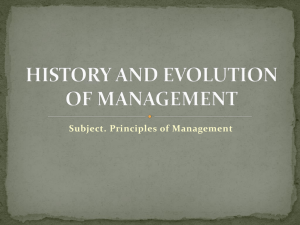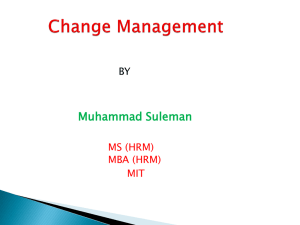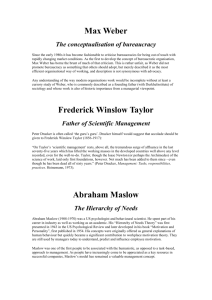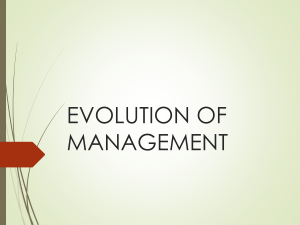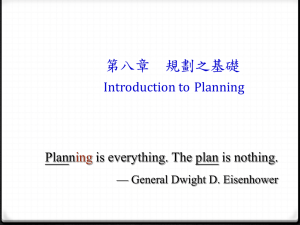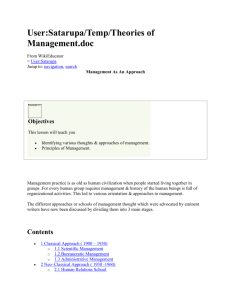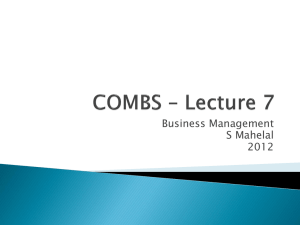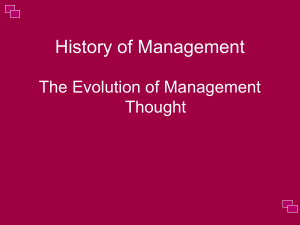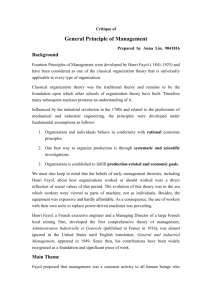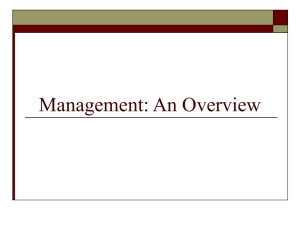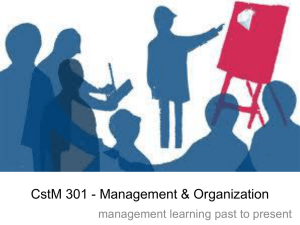Theories of Management: MBO and Path-Goal
advertisement
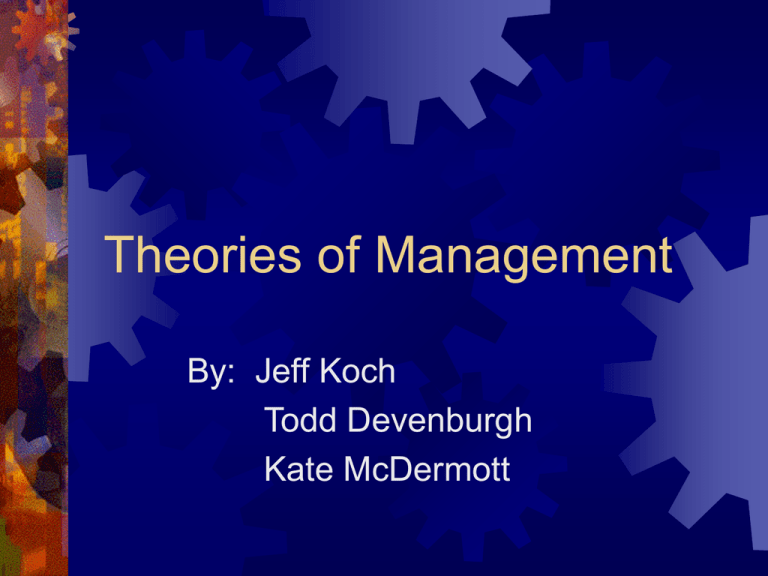
Theories of Management By: Jeff Koch Todd Devenburgh Kate McDermott Scientific Management Scientific management is a method in management theory that determines changes to improve labor productivity. The idea was first coined by Frederick Winslow Taylor in The Principles of Scientific Management in 1911 Frederick Winslow Taylor Developed the theories of Scientific Management His innovations in industrial engineering, particularly in time and motion studies, paid off in dramatic improvements in productivity. Theory of Scientific Management Careful specification and measurement of all organizational tasks. Tasks are standardized as much as possible. Workers are rewarded and punished This approach worked well for organizations with assembly lines and other mechanistic activities Criticism of Scientific Management That humans are not inherently alike. What might be the most efficient way for one person may not be for someone else. Ignores the fact that economic interest are different for management and employees. Operations Management Henri Fayol is described as the father of operations management Proposed five functions of management Planning Organizing Commanding Coordinating Controlling Difference between Henri Fayol and Frederick Winslow Taylor Taylor viewed management processes from the bottom up, while Fayol viewed it from the top down. Fayol wrote that "Taylor's approach differs from the one we have outlined in that he examines the firm from the "bottom up." he starts with the most elemental units of activity -- the workers' actions -then studies the effects of their actions on productivity, devises new methods for making them more efficient, and applies what he learns at lower levels to the hierarchy. 14 Principles of Management Division of Work Authority Discipline Unity of control Unity of Direction Subordination of individual interest Remuneration Centralization Scalar chain (Line of Authority) Order Equity Stability of Tenure of Personnel Initiative Esprit de Corps Application of the 14 Principles Change and Organization Decision-making Skills can be used to improve the effectiveness of a manager Understanding the management can be seen as a variety of activities which can be listed and grouped Behavioral Approach to Management Focused on Human beings and their individual rights Arose low after the following were observed: productivity lack of modern machinery limited horsepower availability anachronistic trade union practices poor management Human Relations Theory Focused on motivation and employee care Found if employees were satisfied with their work, they were more apt to perform better 1880-1949 Conducted Hawthorne Studies Mayo’s Conclusions Work is a group activity The social work of an adult is based on their work experiences Workers need recognition, security, and a sense of belonging Mayo’s Conclusions, Cont. A complaint is usually due to an employee’s dissatisfaction with his or her status A worker’s attitude is shaped from forces inside and outside of the work environment Informal groups in the workplace improve employees’ attitudes and productivity Mayo’s Conclusions, Cont. The change from an established society at home to an adaptive society at work can create disturbances in the workforce Group work must be planned and implemented Human Resources Theory Focused on how an employee viewed their position and work experiences. Found that manager’s ways of managing largely contributed to how an employee viewed their work. 1906 – 1964 Theory X and Theory Y Theory X Average human being dislikes work: Most employees must be controlled and threatened before they will perform to the expectations Humans like to be directed, dislikes responsibility, and wants job security This lead to most organizations using “tough” management Bad form of management because the employee needs the opportunity to fulfill their goals This led employees to dislike their work Theory Y Physical and mental effort at work are very natural Employees will be proactive if they are committed to the company and if the job is satisfying Most employees learn to seek out responsibility Imagination, creativity, and ingenuity can be used to solve work problems Employees are not used to their full capacity Conclusions on Theory X and Y These two theories are impractical at the workforce and are very different McGregor suggested that managers look at the theories to start their view of management MBO MBO=Management by Objectives Top management teams along with employees together define the company goals and direction that the company is going. 3 Key components Specific, achievable, measurable, realistic, time-specific Goals are not unilateral within management Managers give objective feedback MBO Popularized by Peter Drucker in 1954. “Management by objectives works if you know the objectives. Ninety percent of the time you don’t.”-Peter F. Drucker MBO Works well within the U.S. culture, but often fails in others due to different styles in management Ex. French because of their high power distance MBO Works well because all levels are involved in achieving the ultimate goal Path-Goal Theory Developed Remove by Robert House obstacles Clarify the path to the goal Offer rewards 4 Types of Leaders Achievement Oriented Leader sets high goals High performance levels Confident in expectations being met Directive Tells them how to perform tasks What is expected Types of Leader (cont.) Participative Consults with others before making decisions Uses others suggestions to make the final decision Supportive Approachable Friendly Needed when the follower lacks confidence Questions ?
